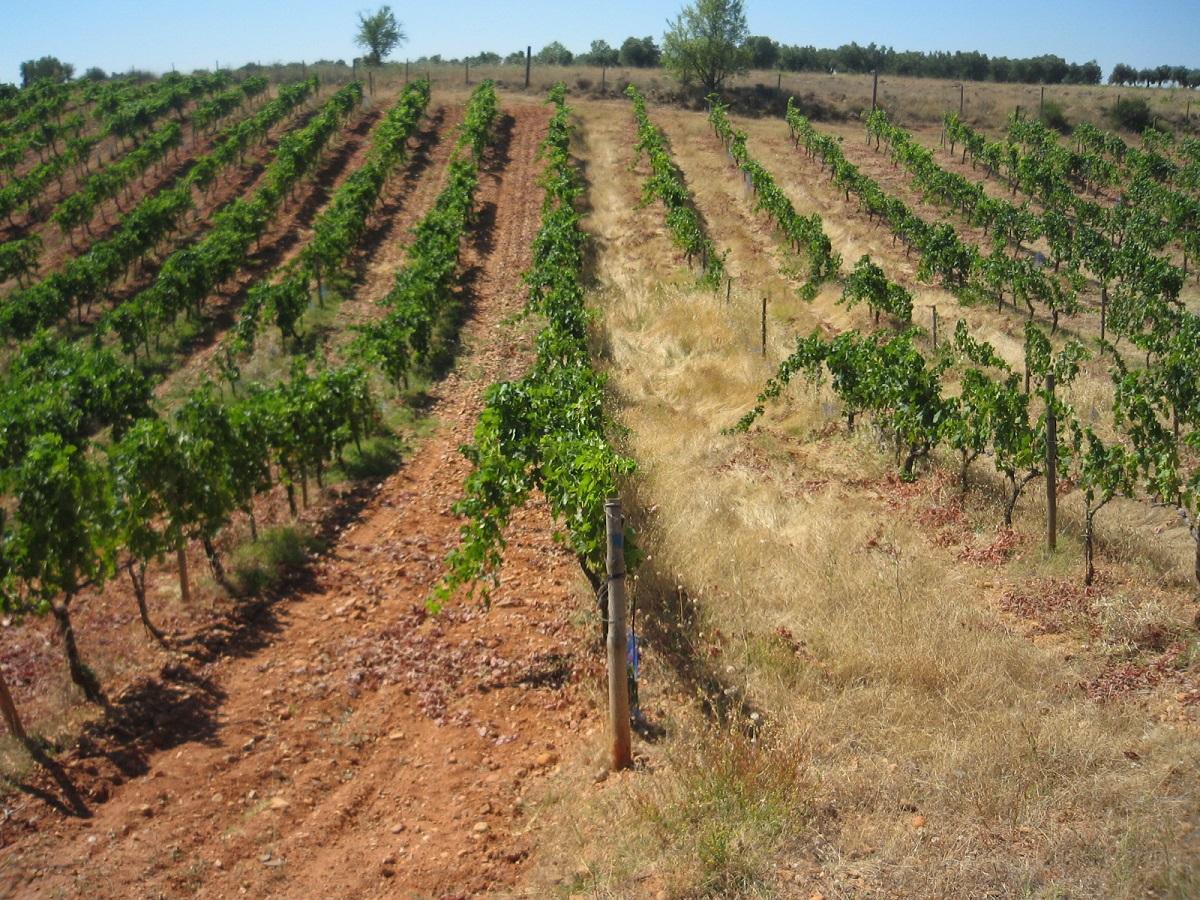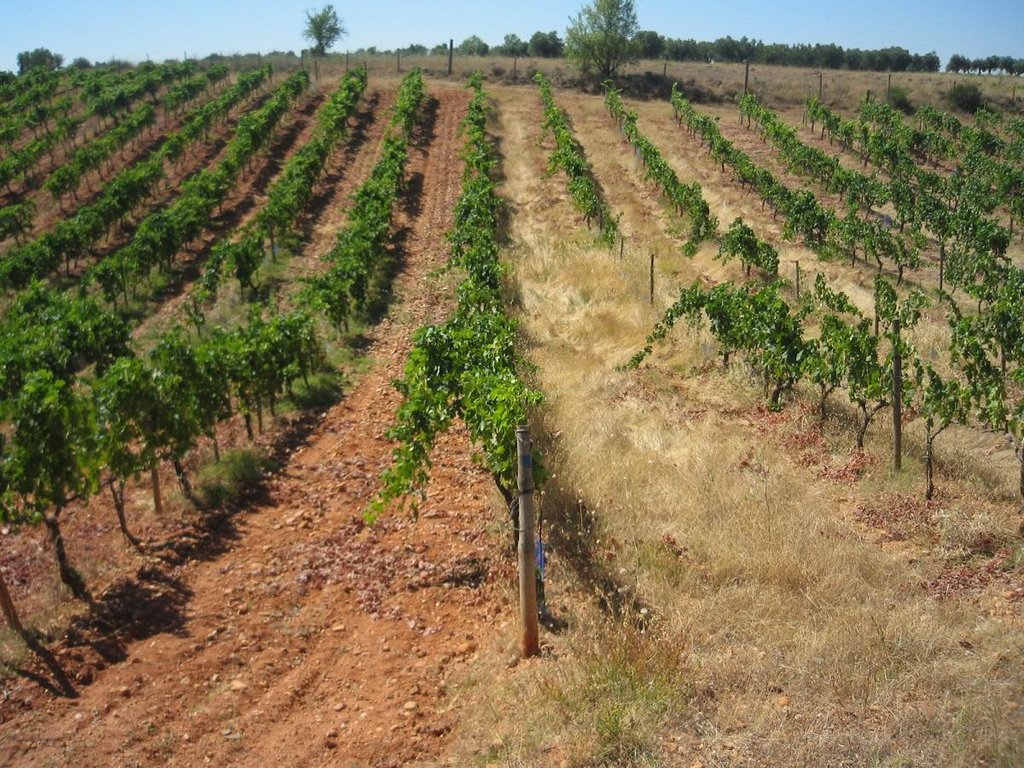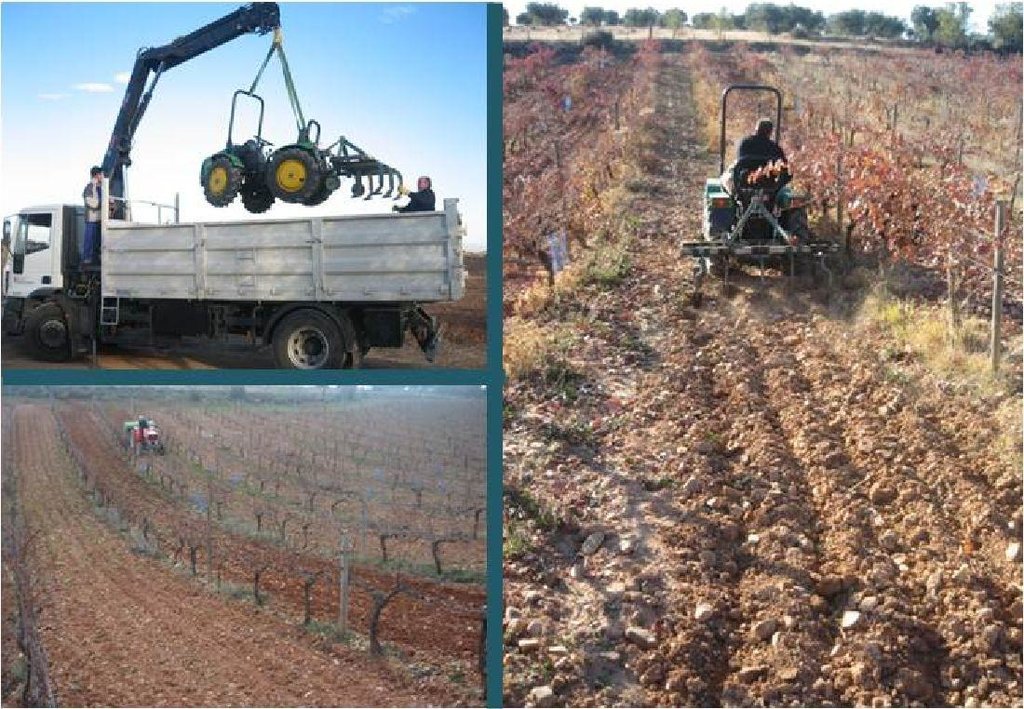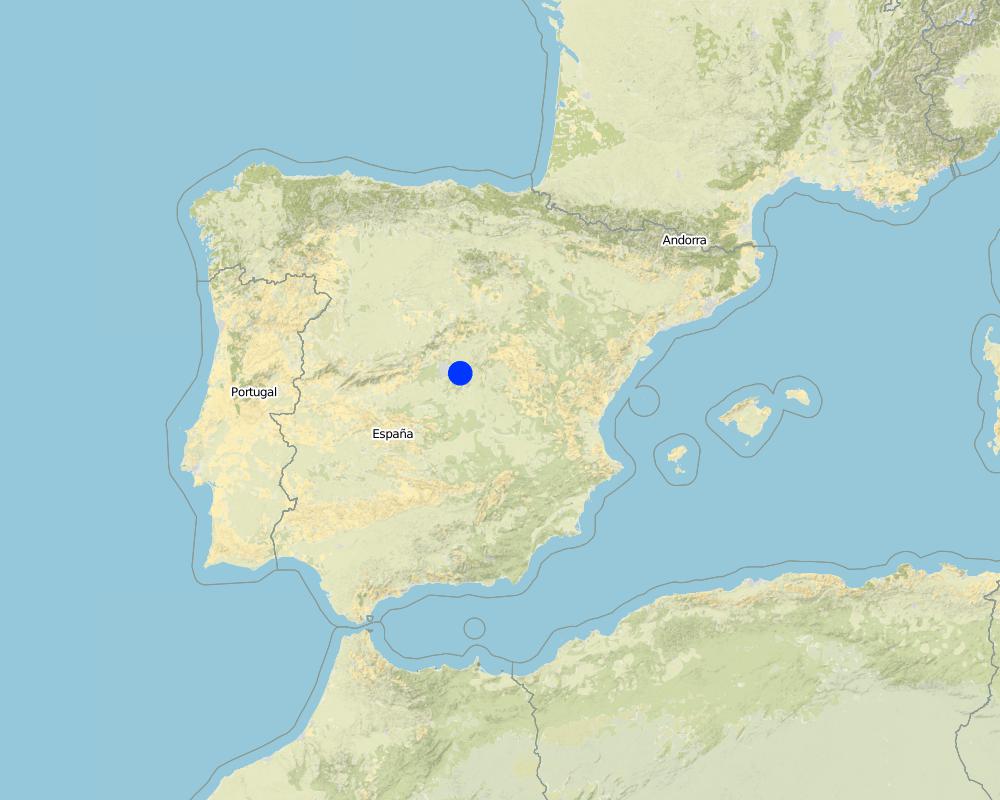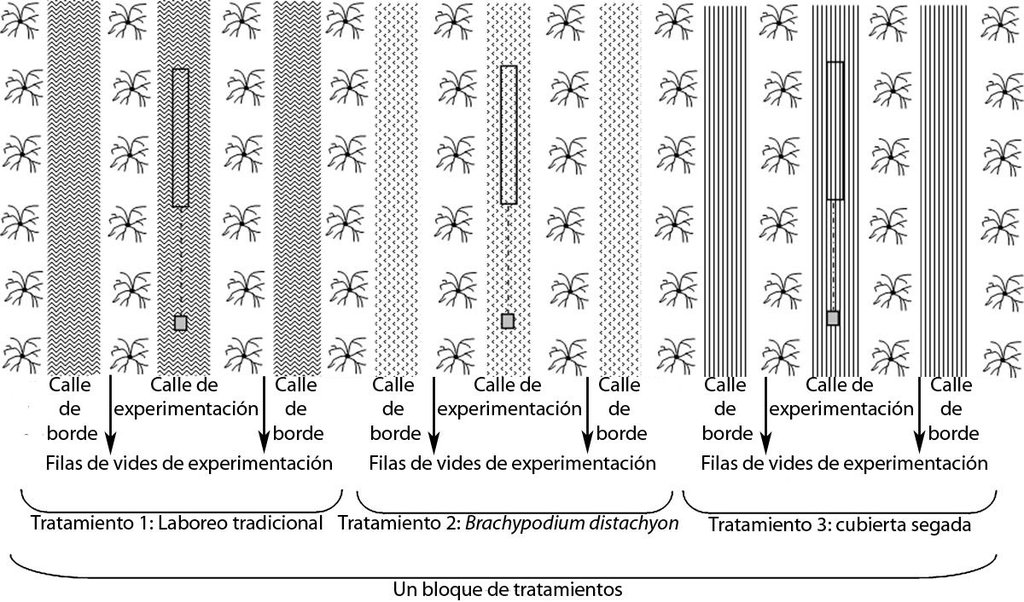Cover crops in organic vineyard [Spain]
- Creation:
- Update:
- Compiler: CELIA BARBERO SIERRA
- Editor: –
- Reviewers: Fabian Ottiger, Alexandra Gavilano
Cubiertas vegetales en calles de viñedos
technologies_1162 - Spain
View sections
Expand all Collapse all1. General information
1.2 Contact details of resource persons and institutions involved in the assessment and documentation of the Technology
SLM specialist:
SLM specialist:
Ruíz Colmenero Marta
Instituto Madrileño de Investigación y Desarrollo Rural, Agrario y Alimentario - IMIDRA
Spain
SLM specialist:
Bienes Ramon
Instituto Madrileño de Investigación y Desarrollo Rural, Agrario y Alimentario - IMIDRA
Name of the institution(s) which facilitated the documentation/ evaluation of the Technology (if relevant)
UNIVERSIDAD AUTONOMA DE MADRID (UNIVERSIDAD AUTONOMA DE MADRID) - SpainName of the institution(s) which facilitated the documentation/ evaluation of the Technology (if relevant)
IMIDRA (IMIDRA) - Spain1.3 Conditions regarding the use of data documented through WOCAT
The compiler and key resource person(s) accept the conditions regarding the use of data documented through WOCAT:
Yes
2. Description of the SLM Technology
2.1 Short description of the Technology
Definition of the Technology:
Use of cover crops to prevent erosion and increase soil organic matter.
2.2 Detailed description of the Technology
Description:
In total there were 66 rows of vineyards of the Tempranillo red variety, spaced 3 m apart with a distance of 2.5 m between vines. To date they have been worked using conventional tilling without herbicides: most of the work is done mainly in the winter, followed by two or three sessions in spring aimed at controlling the growth of weeds, which is conditioned by the spring rains.
The technology is based on minimum tillage and the use of Secale cereale L and Brachypodium distachyon (L.) as cover crops to protect the soil against erosion and to increase the organic matter.
Purpose of the Technology: The main purposes of this technology are to fight against erosion and water runoff and to increase soil organic matter.
Indirectly this technology contributes to increase biodiversity in the vineyards and it could have some positive effects on wine quality (related to the content of sugar and poliphenoles) as proved by some authors (Dry et al., 2001).
Cover crops usually increase the soil moisture but on the other hand, along the summer, the cover crops and the vines are in competition for the scarce water available in the area.
Establishment / maintenance activities and inputs: The plant cover in the centre of the rows was sown in mid-November, following the copious rains in the autumn of 2006. A minimum tillage (15cm depth) is carried out before sowing. The seeding rates were 70 kg/ha for rye, Secale cereale L., and 40 kg/ha for purple false brome, Brachypodium distachyon (L.) P. Beauv. This latter cover had to be reseeded by hand since the seeds have to be buried at a very low depth. It sprouts in late winter or early spring and by late June it is already mature and dry, at which point it self-sows and it sprouts spontaneously again the following autumn. The Secale cover has to be cut in spring and re-sown in late autumn.
Once sown, the resulting vineyard was divided into alternating rows with three treatments: bare soil with traditional tilling, rows covered with Secale and rows covered with Brachypodium.
The maintenance activities consist of no tillage in winter and conservation of natural cover crops until spring.
Natural / human environment: The area is at an altitude of 800 m, in a semiarid Mediterranean climate where the recorded annual rainfall is below 400 mm and the average annual temperature is 14 ºC, with very hot and occasionally stormy summers and very cold winters. It rains primarily in spring and autumn.
The farmland is predominantly dry, especially where olives and vines are planted. Oaks (holm, Portuguese and hermes) can be found in nearby wild areas and in abandoned terrains. The study focused on the area of Campo Real in the southeast of Madrid, in the centre of Spain. The vineyard covers an area of some 2 ha of rolling hills and is located on top of limestone marl.
The farmer is the owner of the land where the technology was implemented as well as he owns other plots. The land user is one of the few organic producers in the region.
2.3 Photos of the Technology
2.5 Country/ region/ locations where the Technology has been applied and which are covered by this assessment
Country:
Spain
Region/ State/ Province:
Madrid, Spain
Further specification of location:
Campo Real
Comments:
Total area covered by the SLM Technology is 0.02 km2.
Map
×2.6 Date of implementation
If precise year is not known, indicate approximate date:
- less than 10 years ago (recently)
2.7 Introduction of the Technology
Specify how the Technology was introduced:
- during experiments/ research
- through projects/ external interventions
Comments (type of project, etc.):
Projects FP 06-DR3-VID IMIDRA and RTA2007-86 INIA, Bodegas y Viñedos Gosálbez-Ortí.
3. Classification of the SLM Technology
3.2 Current land use type(s) where the Technology is applied
Land use mixed within the same land unit:
Yes
Specify mixed land use (crops/ grazing/ trees):
- Agro-pastoralism (incl. integrated crop-livestock)

Cropland
- Tree and shrub cropping
- grass see
Number of growing seasons per year:
- 1
Specify:
Longest growing period in days: 75Longest growing period from month to month: February-April (Secale cereale)Second longest growing period in days: 90Second longest growing period from month to month: February-June (B distachyon)

Other
Specify:
Grass species: rye (Secale cereale) and bromus (Brachypodium distachyon) (2m)
Comments:
Major land use problems (compiler’s opinion): Erosion and low soil organic matter content.
Major land use problems (land users’ perception): Water scarcity, climatic extreme events, low agricultural income.
3.4 Water supply
Water supply for the land on which the Technology is applied:
- rainfed
3.5 SLM group to which the Technology belongs
- improved ground/ vegetation cover
3.6 SLM measures comprising the Technology

agronomic measures
- A1: Vegetation/ soil cover
- A2: Organic matter/ soil fertility
- A3: Soil surface treatment
Comments:
Main measures: agronomic measures
Type of agronomic measures: better crop cover, contour planting / strip cropping, cover cropping, mulching, manure / compost / residues, breaking crust / sealed surface, minimum tillage
3.7 Main types of land degradation addressed by the Technology

soil erosion by water
- Wt: loss of topsoil/ surface erosion

chemical soil deterioration
- Cn: fertility decline and reduced organic matter content (not caused by erosion)

physical soil deterioration
- Pc: compaction
- Pk: slaking and crusting

biological degradation
- Bl: loss of soil life
Comments:
Main type of degradation addressed: Wt: loss of topsoil / surface erosion
Secondary types of degradation addressed: Cn: fertility decline and reduced organic matter content, Pc: compaction, Pk: sealing and crusting, Bl: loss of soil life
Main causes of degradation: soil management (Bare soil by traditional tillage in sloping lands), deforestation / removal of natural vegetation (incl. forest fires) (Lack of vegetation increases soil erodibility), disturbance of water cycle (infiltration / runoff) (Increase the annual rate of rain infiltration due to high vegetation cover), Heavy / extreme rainfall (intensity/amounts) (Extreme events- storms), droughts
Secondary causes of degradation: other natural causes (avalanches, volcanic eruptions, mud flows, highly susceptible natural resources, extreme topography, etc.) specify (Slope between 10 to 15%), land tenure (Uncertainties on future land tenure implies overexploitation of land in the short run)
3.8 Prevention, reduction, or restoration of land degradation
Specify the goal of the Technology with regard to land degradation:
- prevent land degradation
- reduce land degradation
Comments:
Main goals: prevention of land degradation
Secondary goals: mitigation / reduction of land degradation
4. Technical specifications, implementation activities, inputs, and costs
4.1 Technical drawing of the Technology
Technical specifications (related to technical drawing):
Cover crops are sown in the middle of the strips of the lines of vineyard.(Bare soil under the vines: 50 cm wide; cropped strips: 2 m wide)
Location: Campo Real. Madrid, Spain
Date: 2008
Technical knowledge required for field staff / advisors: moderate (Selection of cover crops and management.
Botanical and agronomic knowledge required.)
Technical knowledge required for land users: moderate (Use of appropriate machinery.)
Main technical functions: control of raindrop splash, control of dispersed runoff: retain / trap, control of dispersed runoff: impede / retard, improvement of ground cover, increase of surface roughness, improvement of surface structure (crusting, sealing), improvement of topsoil structure (compaction), stabilisation of soil (eg by tree roots against land slides), increase in organic matter, increase of infiltration, sediment retention / trapping, sediment harvesting, increase of biomass (quantity), promotion of vegetation species and varieties (quality, eg palatable fodder)
Secondary technical functions: increase in nutrient availability (supply, recycling,…), increase / maintain water stored in soil, increase of groundwater level / recharge of groundwater
Better crop cover
Material/ species: Secale cereale
Quantity/ density: 70 kg/ha
Remarks: decrease soil erosion and it does not compete for water.
Contour planting / strip cropping
Material/ species: Vineyard plus cereals
Remarks: bare soil under the vines: 50 cm wide; cropped strips: 2 m wide
Cover cropping
Material/ species: Brachypodium distachyon
Quantity/ density: 40 kg/ha
Remarks: best coverage and SOM increase, but reduces the grape production too much due to water competition
Mulching
Material/ species: Straw of Secale cereale
Remarks: Conservation of cut rye on site
Manure / compost / residues
Material/ species: Secale cereale and Brachypodium distachyon
Remarks: roots and residues (straw) left in soil increase SOM
Breaking crust / sealed surface
Remarks: cover crops avoid soil crusting
Minimum tillage
Material/ species: up to 15 cm soil depth
Quantity/ density: 15 cm
Remarks: before sowing
Vegetative measure: in the middle of the lines of vines
Vegetative material: G : grass
Vegetative measure: Vegetative material: G : grass
Vegetative measure: Vegetative material: G : grass
Vegetative measure: Vegetative material: G : grass
Fruit trees / shrubs species: Grapes (50cm) /grass see G (cover crops) (2m)
Grass species: rye (Secale cereale) and bromus (Brachypodium distachyon) (2m)
Author:
María José Marqués, Universidad Autónoma de Madrid
4.2 General information regarding the calculation of inputs and costs
other/ national currency (specify):
euro
If relevant, indicate exchange rate from USD to local currency (e.g. 1 USD = 79.9 Brazilian Real): 1 USD =:
1.34
Indicate average wage cost of hired labour per day:
46.90
4.3 Establishment activities
| Activity | Timing (season) | |
|---|---|---|
| 1. | Buy secale cereale seed, 70 kg per ha | |
| 2. | Buy B. distachyon seed, 40 kg per ha |
4.4 Costs and inputs needed for establishment
| Specify input | Unit | Quantity | Costs per Unit | Total costs per input | % of costs borne by land users | |
|---|---|---|---|---|---|---|
| Labour | Labour | ha | 1.0 | 140.7 | 140.7 | 100.0 |
| Equipment | Machine use | ha | 1.0 | 51.46 | 51.46 | 100.0 |
| Plant material | Seeds | ha | 1.0 | 354.43 | 354.43 | |
| Total costs for establishment of the Technology | 546.59 | |||||
| Total costs for establishment of the Technology in USD | 407.9 | |||||
Comments:
Duration of establishment phase: 6 month(s)
Life span of the product: B. distachyon seed, 4-5 years
Life span of the product: Secale cereale seed, 1 year
4.5 Maintenance/ recurrent activities
| Activity | Timing/ frequency | |
|---|---|---|
| 1. | Minimum tillage and seeding in one go (Secale cereale) | Annually in late autumn or winter |
| 2. | Seeding (B distachyon) | Every 5 years |
| 3. | Mowing Secale cereale 1 ha | Once a year |
4.6 Costs and inputs needed for maintenance/ recurrent activities (per year)
| Specify input | Unit | Quantity | Costs per Unit | Total costs per input | % of costs borne by land users | |
|---|---|---|---|---|---|---|
| Labour | Labour | ha | 1.0 | 140.7 | 140.7 | 100.0 |
| Equipment | Machine use | ha | 1.0 | 51.46 | 51.46 | 100.0 |
| Plant material | Seeds | ha | 1.0 | 113.23 | 113.23 | |
| Total costs for maintenance of the Technology | 305.39 | |||||
| Total costs for maintenance of the Technology in USD | 227.9 | |||||
Comments:
Machinery/ tools: tractor, brushcutter
Grass strips per hectare in 2008.
4.7 Most important factors affecting the costs
Describe the most determinate factors affecting the costs:
Labour and price of B. distachyon seeds as it is not a commercial seed.
5. Natural and human environment
5.1 Climate
Annual rainfall
- < 250 mm
- 251-500 mm
- 501-750 mm
- 751-1,000 mm
- 1,001-1,500 mm
- 1,501-2,000 mm
- 2,001-3,000 mm
- 3,001-4,000 mm
- > 4,000 mm
Specify average annual rainfall (if known), in mm:
400.00
Specifications/ comments on rainfall:
Autumn and spring
Agro-climatic zone
- semi-arid
Thermal climate class: temperate
5.2 Topography
Slopes on average:
- flat (0-2%)
- gentle (3-5%)
- moderate (6-10%)
- rolling (11-15%)
- hilly (16-30%)
- steep (31-60%)
- very steep (>60%)
Landforms:
- plateau/plains
- ridges
- mountain slopes
- hill slopes
- footslopes
- valley floors
Altitudinal zone:
- 0-100 m a.s.l.
- 101-500 m a.s.l.
- 501-1,000 m a.s.l.
- 1,001-1,500 m a.s.l.
- 1,501-2,000 m a.s.l.
- 2,001-2,500 m a.s.l.
- 2,501-3,000 m a.s.l.
- 3,001-4,000 m a.s.l.
- > 4,000 m a.s.l.
Indicate if the Technology is specifically applied in:
- concave situations
Comments and further specifications on topography:
Slopes on average: Rolling (10-14%)
5.3 Soils
Soil depth on average:
- very shallow (0-20 cm)
- shallow (21-50 cm)
- moderately deep (51-80 cm)
- deep (81-120 cm)
- very deep (> 120 cm)
Soil texture (topsoil):
- medium (loamy, silty)
Topsoil organic matter:
- medium (1-3%)
If available, attach full soil description or specify the available information, e.g. soil type, soil PH/ acidity, Cation Exchange Capacity, nitrogen, salinity etc.
Soil texture is medium (sandy loam)
Soil fertility is medium
Topsoil organic matter is medium (1.3%)
Soil drainage/infiltration is medium
Soil water storage capacity is medium
5.4 Water availability and quality
Availability of surface water:
medium
Water quality (untreated):
poor drinking water (treatment required)
Comments and further specifications on water quality and quantity:
Ground water table: No data avalilable
Availability of surface of water: During the maximum water requirements of vines (June-July) water is not available usually.
5.5 Biodiversity
Species diversity:
- low
5.6 Characteristics of land users applying the Technology
Market orientation of production system:
- commercial/ market
Relative level of wealth:
- average
Individuals or groups:
- individual/ household
Level of mechanization:
- mechanized/ motorized
Gender:
- men
Indicate other relevant characteristics of the land users:
Land users applying the Technology are mainly Leaders / privileged
Difference in the involvement of women and men: Traditionally vineyard sector in Spain is driven by men.
Population density: 10-50 persons/km2
Annual population growth: negative
Off-farm income specification: This information is not available.
Market orientation is commercial/market (wine).
5.7 Average area of land used by land users applying the Technology
- < 0.5 ha
- 0.5-1 ha
- 1-2 ha
- 2-5 ha
- 5-15 ha
- 15-50 ha
- 50-100 ha
- 100-500 ha
- 500-1,000 ha
- 1,000-10,000 ha
- > 10,000 ha
Is this considered small-, medium- or large-scale (referring to local context)?
- small-scale
5.8 Land ownership, land use rights, and water use rights
Land ownership:
- individual, titled
Land use rights:
- individual
Water use rights:
- individual
5.9 Access to services and infrastructure
health:
- poor
- moderate
- good
education:
- poor
- moderate
- good
technical assistance:
- poor
- moderate
- good
employment (e.g. off-farm):
- poor
- moderate
- good
markets:
- poor
- moderate
- good
energy:
- poor
- moderate
- good
roads and transport:
- poor
- moderate
- good
drinking water and sanitation:
- poor
- moderate
- good
financial services:
- poor
- moderate
- good
6. Impacts and concluding statements
6.1 On-site impacts the Technology has shown
Socio-economic impacts
Production
crop production
Comments/ specify:
Depending on the cover crop (B. distachyon)
fodder production
Comments/ specify:
But not really used
Water availability and quality
irrigation water availability
irrigation water quality
demand for irrigation water
Income and costs
farm income
Comments/ specify:
Related to the quality and price of wine
workload
Comments/ specify:
No tillage
Socio-cultural impacts
SLM/ land degradation knowledge
Landusers perception of the landscape
Comments/ specify:
The farmers use to prefer the landscape of their vineyards with "clean" soil. They consider cover crops as weeds.
Improved livelihoods and human well-being
Comments/ specify:
This SLM Technology contributes to soil improvement but has no direct impacts on human wellbeing of the land users. Due to organic labelling of the product, the price of wine may increase wich also increases farm income.
Ecological impacts
Water cycle/ runoff
surface runoff
Comments/ specify:
More than 80% of runoff reduction in B. distachyon and more than 60% for Secale.
evaporation
Soil
soil moisture
Comments/ specify:
Depending on the cover. B. distachyon increases soil moisture in autumn and winter. From May to July soil moisture heavely decreased, the rest of the year the cover crops increase soil moisture compared with bare soil
soil cover
soil loss
Comments/ specify:
93% in permanent cover crops
soil crusting/ sealing
soil compaction
Comments/ specify:
Due to less use of heavy machinery
soil organic matter/ below ground C
Quantity before SLM:
1.27%
Quantity after SLM:
1.6%
Comments/ specify:
From 1.27% to 1.6% in three years for permanent covers
6.2 Off-site impacts the Technology has shown
water availability
downstream flooding
groundwater/ river pollution
buffering/ filtering capacity
wind transported sediments
damage on neighbours' fields
damage on public/ private infrastructure
6.3 Exposure and sensitivity of the Technology to gradual climate change and climate-related extremes/ disasters (as perceived by land users)
Gradual climate change
Gradual climate change
| Season | increase or decrease | How does the Technology cope with it? | |
|---|---|---|---|
| annual temperature | increase | well |
Climate-related extremes (disasters)
Meteorological disasters
| How does the Technology cope with it? | |
|---|---|
| local rainstorm | well |
| local windstorm | not known |
Climatological disasters
| How does the Technology cope with it? | |
|---|---|
| drought | well |
Hydrological disasters
| How does the Technology cope with it? | |
|---|---|
| general (river) flood | not well |
Other climate-related consequences
Other climate-related consequences
| How does the Technology cope with it? | |
|---|---|
| reduced growing period | well |
Comments:
The species were chosen to be tolerant to drought and poor soil conditions
6.4 Cost-benefit analysis
How do the benefits compare with the establishment costs (from land users’ perspective)?
Short-term returns:
neutral/ balanced
Long-term returns:
slightly positive
How do the benefits compare with the maintenance/ recurrent costs (from land users' perspective)?
Short-term returns:
neutral/ balanced
Long-term returns:
slightly positive
Comments:
This particular land user is an organic farmer and he is willing to change his manangament practices but tradtional farmers in the region have a very negative vision of this kind of SLM techs.
6.5 Adoption of the Technology
If available, quantify (no. of households and/ or area covered):
1
Comments:
100% of land user families have adopted the Technology with external material support
1 land user families have adopted the Technology with external material support
There is no trend towards spontaneous adoption of the Technology
6.7 Strengths/ advantages/ opportunities of the Technology
| Strengths/ advantages/ opportunities in the land user’s view |
|---|
|
Increase in wine quality How can they be sustained / enhanced? Maintaining this SLM practice along the time |
|
Prevention of erosion How can they be sustained / enhanced? Maintaining this SLM practice along the time |
|
Decrease in intensity and frequency of tillage How can they be sustained / enhanced? Maintaining this SLM practice along the time |
| Strengths/ advantages/ opportunities in the compiler’s or other key resource person’s view |
|---|
|
Increase of soil organic matter How can they be sustained / enhanced? Maintaining this SLM practice along the time |
|
Prevention of runoff and soil erosion (change of bare (tilled) soil by cover crops) How can they be sustained / enhanced? Maintaining this SLM practice along the time |
|
Increase in biodiversity How can they be sustained / enhanced? Maintaining this SLM practice along the time |
|
Increase in wine quality (related to the content of sugar and polyphenols), as proved by some authors (Dry et al., 2001) How can they be sustained / enhanced? Maintaining this SLM practice along the time |
|
The costs are reduced through reduced use of tractor (decreased intensity of tillage) How can they be sustained / enhanced? Maintaining this SLM practice along the time |
6.8 Weaknesses/ disadvantages/ risks of the Technology and ways of overcoming them
| Weaknesses/ disadvantages/ risks in the land user’s view | How can they be overcome? |
|---|---|
| Lack of knowledge or training to adopt this technologies | Awareness raising campaigns |
| Weaknesses/ disadvantages/ risks in the compiler’s or other key resource person’s view | How can they be overcome? |
|---|---|
| Soil moisture decreases during certain months | Mowing the cover in spring |
| High costs of the most effective seed (8.04$/kg) (B. distachyon) | Using other similar and cheaper seeds |
7. References and links
7.1 Methods/ sources of information
7.2 References to available publications
Title, author, year, ISBN:
M.J. Marques , S. García-Muñoz , G. Muñoz-Organero , R. Bienes. 2009. Soil conservation beneath grass cover in hillside vineyards under mediterranean climatic conditions. Land Degradation and Development. 21: 122-131.
Ruiz-Colmenero, S; Bienes R.; Marques MJ. 2011. Soil and water conservation dilemmas associated with the use of green cover in steep vineyards. Soil & Tillage Research 117, 211-223.
Bienes R., Marques MJ, Ruiz Colmenero M 2012. Cereales, viñedos y olivares. El manejo tradicional del suelo y sus consecuencias en la erosión hídrica. La erosión y la hidrología en campos de cultivo en España. Cuadernos de Investigación Geográfica 38(1), 49-74.
Ruiz-Colmenero, M., Bienes, R., Eldridge, D.J. and Marqués, M.J. 2013. Vegetation cover reduces erosion and enhances soil organic carbon in a vineyard in the central Spain. Catena. 104, 153-160.
Links and modules
Expand all Collapse allLinks
No links
Modules
No modules


